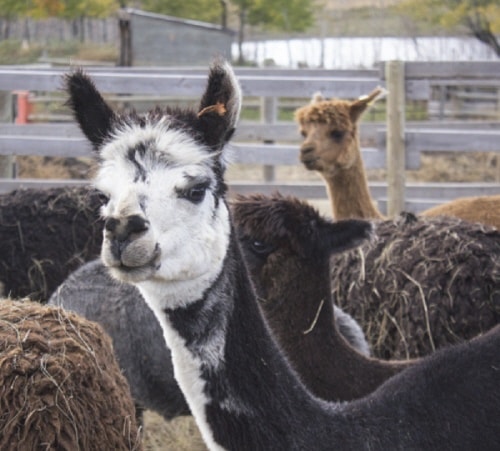Ask Karen Wahlund what the appeal of raising alpacas is, and she’ll tell you in one word: personality.
She and her husband, Murray, have 37 of the woolly creatures, each one with its own name.
“Most of them will come to their names,” she said, adding that the animals each have distinct characteristics and personalities. “They grow on you.”
Romulus, for example, was bottle-fed by his previous owners, and he’s still very affectionate, always approaching to be petted.
Duchess is among the oldest in the pack; she was one of the first alpacas acquired by the Wahlunds back in 2005.
Even at Duchess’s advanced age — Karen estimates she’s pushing 25 years old — she still acts as something of a mother among the alpacas on the Wahlund farm.
Alpacas are among the species of the camel family, descending from South America along with llamas, vicuñas and guanacos.
While llamas were bred as pack animals, alpacas are primarily raised for their fibre. It is similar to wool, but it is warmer, softer and hypoallergenic.
Nine years ago, the Wahlunds acquired two alpacas and three llamas. They quickly found that they preferred the alpacas.
“They’re more personable,” Karen says by way of explanation.
Several of the female alpacas are expecting, and Karen says they’ll likely be welcoming some newborns — or “crias” — in the spring.
The Wahlunds have their alpacas sheared every other year. Murray used to do the shearing himself, but since he injured his shoulder and underwent surgery, the task has fallen to Ernie and Denise Gamroth, who operate Battle River Alpacas.
Karen said the shearers typically leave some wool on the alpacas’ head, tail and lower legs, as it keeps them warm in the winter and blocks the sun in the summer.
The sheared wool is milled into yarn. Karen previously spun the wool herself, but after the arrival of their three children, she has relied upon other mills to do the processing.
The wool — which comes in a range of tones, from white and grey to tan, brown and black — is made into several products, including mitts, toques, scarves and sweaters.
Typically, alpacas are peaceful creatures unless they’re upset or agitated.
The arrival of any predator on the quarter-section — coyote, deer, moose or an unfamiliar person — will set off a high-pitched whine not unlike the sound of a car alarm.
They are known to spit, but only when they feel threatened or if they’re acting aggressive towards each other.
And they’re fast. Karen told the story of following the alpacas after they’d escaped into a nearby field, driving after them in a truck and clocking them at 35 kilometres per hour.
In addition to three dozen alpacas, the Wahlunds still have two llamas and a couple of llama-alpaca mixes on their farm west of Stettler. The family also raises ducks and chickens.
